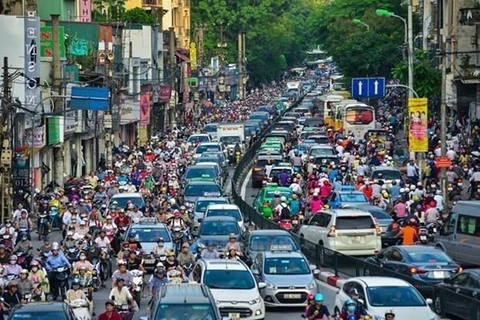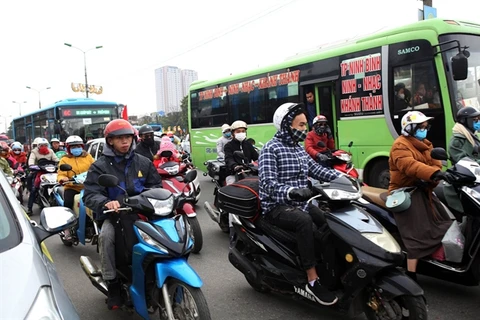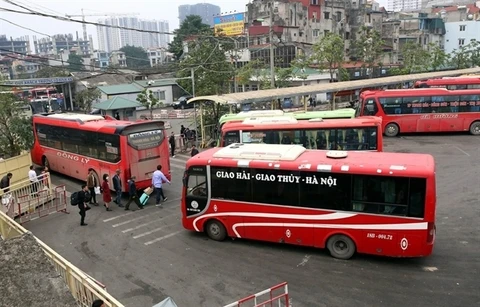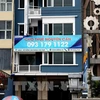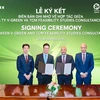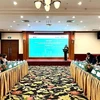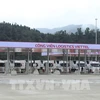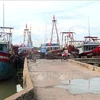Hanoi (VNS/VNA) - Building transport infrastructure is hoped to help Hanoi’s outskirts areas develop and create the potential for modern urban development as there is less and less land available in the inner city.
The Ring Road No 2 project is an example.
The Ring Road No 2 project is an example.
The 5.1km road connecting Vinh Tuy Bridge to Nga Tu So (So intersection) worth 9.4 trillion VND (408 million USD), of which 4.19 trillion VND (182 million USD) was for site clearance, was started in April 2018 and planned to put into operation this year.
When the route is completed it will not only help improve urban traffic but also facilitate the travel needs of local residents.
In addition, a project to widen Vinh Tuy Bridge will directly connect the routes from the inner city to the areas along the Red River's banks, meeting the increasing transport demand between central Hanoi and new urban residential areas in the north and northeast of the city.
Completing the bridge and ring road brings the opportunity to increase the value of real estate tremendously, facilitate people’s travel needs and attract millions of people to move from the central city to suburban areas, according to architect Tran Huy Anh.
The project of connecting Ring Road No 3, Thanh Tri Bridge and Thang Long Bridge with a total length of 26km has helped solve a series of serious conflicts between the ring road and six boulevards to the city, significantly improved urban traffic congestion and increased the value of hundreds and thousands of real estate projects along the route, Anh said.
According to the city's master plan, by 2030, Hanoi is set to have eight urban rail routes with a total length of 318km linking the central city with satellite and suburban cities.
The municipal authority plans to borrow about 40 billion USD to build the rail routes.
Initially, the city has focused on operating 20km of elevated railway and speeding up the construction progress of 4km of track and four underground stations of the Nhon Urban Railway.
Building urban railway lines is essential, but progress has been slow.
In 2018 in the guiding document for urban transport development, the World Bank recommended developing cities and countries with limited financial resources need to be alert to choose the optimal solution to avoid pitfalls which are costly and dependent on creditors.
Therefore, the selection of optimal urban transport system planning should be based on an analysis of capacity and social impact.
In addition, it is necessary to analyse the accessibility of infrastructure, especially for students, workers and public servants.
Taking into account the lowest affordability for all people, especially low-income persons, is also essential.
The private sector's support is needed to develop the urban railway system.
Finally, the quality of the urban transport infrastructure and the user services, including comfort, safety, security, and reliability, must be ensured.
This year, more than 20km of elevated lines are scheduled to be put into operation, including 12km of the Cat Linh – Ha Dong line and 8.5km of the Nhon - University of Transport line.
When operating, the urban railway lines are expected to reduce traffic congestion, urban pollution and improve the quality of life for people in the western area of Hanoi./.
When the route is completed it will not only help improve urban traffic but also facilitate the travel needs of local residents.
In addition, a project to widen Vinh Tuy Bridge will directly connect the routes from the inner city to the areas along the Red River's banks, meeting the increasing transport demand between central Hanoi and new urban residential areas in the north and northeast of the city.
Completing the bridge and ring road brings the opportunity to increase the value of real estate tremendously, facilitate people’s travel needs and attract millions of people to move from the central city to suburban areas, according to architect Tran Huy Anh.
The project of connecting Ring Road No 3, Thanh Tri Bridge and Thang Long Bridge with a total length of 26km has helped solve a series of serious conflicts between the ring road and six boulevards to the city, significantly improved urban traffic congestion and increased the value of hundreds and thousands of real estate projects along the route, Anh said.
According to the city's master plan, by 2030, Hanoi is set to have eight urban rail routes with a total length of 318km linking the central city with satellite and suburban cities.
The municipal authority plans to borrow about 40 billion USD to build the rail routes.
Initially, the city has focused on operating 20km of elevated railway and speeding up the construction progress of 4km of track and four underground stations of the Nhon Urban Railway.
Building urban railway lines is essential, but progress has been slow.
In 2018 in the guiding document for urban transport development, the World Bank recommended developing cities and countries with limited financial resources need to be alert to choose the optimal solution to avoid pitfalls which are costly and dependent on creditors.
Therefore, the selection of optimal urban transport system planning should be based on an analysis of capacity and social impact.
In addition, it is necessary to analyse the accessibility of infrastructure, especially for students, workers and public servants.
Taking into account the lowest affordability for all people, especially low-income persons, is also essential.
The private sector's support is needed to develop the urban railway system.
Finally, the quality of the urban transport infrastructure and the user services, including comfort, safety, security, and reliability, must be ensured.
This year, more than 20km of elevated lines are scheduled to be put into operation, including 12km of the Cat Linh – Ha Dong line and 8.5km of the Nhon - University of Transport line.
When operating, the urban railway lines are expected to reduce traffic congestion, urban pollution and improve the quality of life for people in the western area of Hanoi./.
VNA

